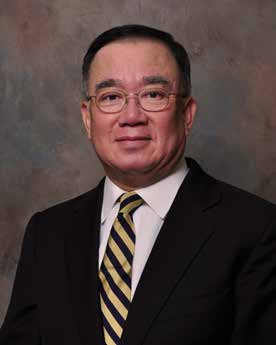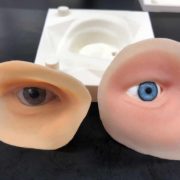WORLD’S FIRST PROSTHETIC 3D EYE IS LATEST BREAKTHROUGH FOR BASCOM PALMER

David T. Tse, MD
Dedicated to his patients’ appearance and comfort and psychological wellbeing, as well as their medical care, David T. Tse, M.D., has spent years trying to find an alternative to the time-consuming and costly process of fabricating a prosthetic for the orbital socket.
“My objective is to convert prosthesis fabrication to a low-cost, non-contact process that is adaptable to a remote setting,” said Tse, professor of ophthalmology and holder of the Dr. Nassar Ibrahim Al-Rashid Chair in Ophthalmic Plastic, Orbital Surgery and Oncology.
Tse’s breakthrough came when he realized that digital scans of the patients’ healthy eye could be “flipped” and merged with images of the empty eye socket. This composite is then sent to a 3D printer to create a prosthetic eyeball and socket from plastic materials – a brand-new process in the field of ophthalmology.
“I was watching a National Geographic special about the space shuttle on TV,” he said. “One of the astronauts had lost a wrench in space, and the ground crew was able to scan a similar wrench and transmit the data to reproduce it with a 3D printer in the shuttle. I said to myself, ‘We can do that for patients across the world who need prosthesis.'”
Now in the experimental state, the realistic prosthesis gives patients a positive alternative to wearing an eye patch. Cancer survivor Rich Arkush, a marketing professional at Smith Research in Deerfield, Illinois, wore an eye patch for 12 years rather than wear an uncomfortable prosthetic. In 2005, he was diagnosed with adenoid cystic carcinoma (AdCC) of the lacrimal gland, Tse and his team implemented a novel treatment protocol developed at Bascom Palmer to destroy the tumor and save his life.
“After the cancer removal, I had six rounds of chemotherapy and radiation and stayed in touch with Dr.Tse.” said Arkush.
Earlier this year, Arkush flew to Miami and tried an initial version of the new 3-D printed prosthesis. Two “fitting” modifications were made using the digital data. So he did not have to travel to Bascom Palmer.
“The last prosthesis from Dr. Tse really hit it out of the park,” Arkush said. “ It’s very comfortable, fits well and looks good on me. I can’t say enough good things about Dr. Tse. I’m still here 13 years after my cancer diagnosis, and now I can wear the new prosthesis instead of a patch.”
To develop the new prosthesis, Tse worked closely with University of Miami biomedical engineers Landon Grace and Mauro Fittipaldi, and ophthalmology researchers using new equipment within the laboratories of the Nasser Al-Rashid Research Center funded by philanthropic donations.
“It’s been a team effort every step of the way,” said Daniel Palaez, Ph.D., research assistant professor of the ophthalmology and biomedical engineering and scientific director of the Nasser AL-Rashid Orbital Vision Research Center.
“Through the research and development stage, we have been able to automate many of the scanning and production steps, accelerating the process while improving the comfort and fit of the prostheses.”
Now, Tse, Paleaz and their team members are excited about the potential for changing the traditional process for the better.
“We can create these prostheses faster, better, and cheaper – and we’re just getting started,” said Palaez.
At the Bascom Palmer research center, Palaez and his team first use a portable 3D laser scanner to capture images of the patient’s healthy eye and orbit. The device can do 800 scans per second, so the process takes about 10 minutes per eye.
“Because the scanner is handheld, it would be possible to capture digital information from patients anywhere in the world,” said Tse.
Next, a color meter is used to measure the patient’s skin tone and the color of the patient’s iris is also identified for a better match of the eyeball. Then, a digital representation of the empty orbital region is constructed using a similar scanning process.
Facial features are used to maintain the symmetry of the two eyes as mirrored data from the healthy eye is combined with the orbital defect scan. Finally, the 3D surfaces are meshed to define the shape of the prosthesis.
Meanwhile, the lab team mixes a biocompatible elastomer (liquid paste) with colored particulates to match the patient’s skin tone, like mixing paint in a hardware store. Then the digital information is sent to a 3D printer that molds the elastomer into the right size and shape.
Because the data is stored securely, it can be used to make multiple prostheses if necessary in the future.
After the polymer material cures overnight, a sealant is applied to the outside surface. However, the back remains soft and pliable for easy insertion and removal from socket.
Finally, acrylic paints are used on the front of the prosthetic to create a realistic appearance.
“That’s the artistic part,” said Palaez. “It takes about an hour to hand paint the subtle details of each eye, and you need a steady hand.”
The result of this innovative biomedical process can be life changing. Having demonstrated the effectiveness of this new process, Tsec and his team hope to move into large scale production, creating prostheses for patients around the world.
“We have been able to reduce the turnaround time on each prosthesis in our laboratory to about three days,” said Pelaez.
“Now, we would like to scale up the process using larger, industrial-scale equipment and developing portable units that could be deployed around the world.”
Ideally, a local eye specialist in Asia, Africa, or the developed world could use a portable scanner or a mobile kiosk to capture a patient’s digital facial data. Then the information could be uploaded to Bascom Palmer to produce the prosthesis, which could then be shipped back directly to the patient almost anywhere in the world.




Leave a Reply
Want to join the discussion?Feel free to contribute!